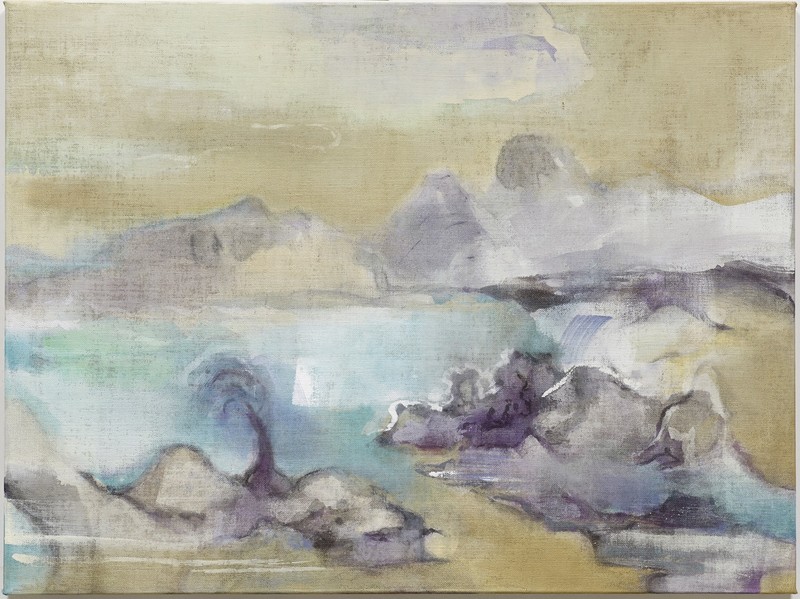Leiko Ikemura - oro y plata
06 Sep - 02 Nov 2013
Anonymous figures, lost in thought, slightly blurry female creatures and cosmic landscapes leading into an infinite space – since the mid-1990s, Leiko Ikemura’s work has developed into a distinctive and homogenous oeuvre. During DC OPEN, Galerie Karsten Greve is devoting a comprehensive solo show to current works by Leiko Ikemura.
Born and raised in Japan, as a young student Leiko Ikemura decided to live in Europe, initially in Spain, then in Switzerland and finally in Germany. It is often said that her work is characterised by the encounter of two cultures: it processes Western art history, but the themes and formal vocabulary also immerse the beholder in Japanese tradition, which venerates asymmetry, incompleteness, and ambiguity. “Imagination is the strongest force in my work”, says the artist, and it is precisely this play of completing something with imagination and thus entering into a dialogue with the Western tradition, which is oriented towards limits, an avoidance of ambiguity, and symmetry. Ikemura’s art is the attempt to elude rational control and to immerse herself and the beholder in sensual and emotional experience. The beholder seems to find himself in a kind of intermediate world, in horizon landscapes with visually unlimited pictorial spaces, or in cosmic landscapes whose forms may be interpreted anthropomorphically – human creatures take on the shapes of animals, or trees or rocks metamorphose into human faces. The transitions are always fluid – in painting and sculpture, in landscape and in human portrayals. Leiko Ikemura consistently foregoes individualising her depictions, and she forms her figuration out of pure corporeality. If her landscapes reveal themselves as a space of many possibilities, it seems all the more contradictory that the artist has developed a special interest in the direct depiction of faces. But her watercolour portraits also remain as unembodied and show as much as they hide. In uncontrolled layers of painting, the portrait becomes independent and refuses the role of faithful depiction in favour of “facial landscapes” that are also committed to the overarching theme of her art: overcoming the subject-object dualism.
Leiko Ikemura was bon in Ts, Japan. She studied sculpture in Osaka, Seville, and Granada. Drom 19679 to 1983 she lived in Switzerland, and from 1985 onwards in Cologne. In 1983, Leiko Ikemura had her first solo exhibition at Bonn’s Kunstverein, with numerous subsequent exhibitions in renowned institutions: Beyond the Horizon at the Toyota Municipal Museum of Art / Toyota (2000), Sculpture Painting Drawing at Kunsthalle Recklinghausen (2004-2005), „Zwischenräume: Leiko Ikemura und Günther Förg at Langen Foundation / Neuss (2007), Leiko Ikemura: Transfiguration at the National Museum of Modern Art, Tokyo (2011), Leiko Ikemura: Mare e Monti at the Kolumba Museum in Colone (2012), Leiko Ikemura: Korekara oder die Heiterkeit des fragilen Seins at the Museum für Asiatische Kunst, Berlin (2012) and Leiko Ikemura: i-migration at Staatliche Kunsthalle Karlsruhe (2013). Leiko Ikemura lives and in Cologne and Berlin, where in 1991 she was appointed professor of painting at the Hochschule der Künste (today: Universität der Künste). In 2009, she received the August-Macke-Preis.
Born and raised in Japan, as a young student Leiko Ikemura decided to live in Europe, initially in Spain, then in Switzerland and finally in Germany. It is often said that her work is characterised by the encounter of two cultures: it processes Western art history, but the themes and formal vocabulary also immerse the beholder in Japanese tradition, which venerates asymmetry, incompleteness, and ambiguity. “Imagination is the strongest force in my work”, says the artist, and it is precisely this play of completing something with imagination and thus entering into a dialogue with the Western tradition, which is oriented towards limits, an avoidance of ambiguity, and symmetry. Ikemura’s art is the attempt to elude rational control and to immerse herself and the beholder in sensual and emotional experience. The beholder seems to find himself in a kind of intermediate world, in horizon landscapes with visually unlimited pictorial spaces, or in cosmic landscapes whose forms may be interpreted anthropomorphically – human creatures take on the shapes of animals, or trees or rocks metamorphose into human faces. The transitions are always fluid – in painting and sculpture, in landscape and in human portrayals. Leiko Ikemura consistently foregoes individualising her depictions, and she forms her figuration out of pure corporeality. If her landscapes reveal themselves as a space of many possibilities, it seems all the more contradictory that the artist has developed a special interest in the direct depiction of faces. But her watercolour portraits also remain as unembodied and show as much as they hide. In uncontrolled layers of painting, the portrait becomes independent and refuses the role of faithful depiction in favour of “facial landscapes” that are also committed to the overarching theme of her art: overcoming the subject-object dualism.
Leiko Ikemura was bon in Ts, Japan. She studied sculpture in Osaka, Seville, and Granada. Drom 19679 to 1983 she lived in Switzerland, and from 1985 onwards in Cologne. In 1983, Leiko Ikemura had her first solo exhibition at Bonn’s Kunstverein, with numerous subsequent exhibitions in renowned institutions: Beyond the Horizon at the Toyota Municipal Museum of Art / Toyota (2000), Sculpture Painting Drawing at Kunsthalle Recklinghausen (2004-2005), „Zwischenräume: Leiko Ikemura und Günther Förg at Langen Foundation / Neuss (2007), Leiko Ikemura: Transfiguration at the National Museum of Modern Art, Tokyo (2011), Leiko Ikemura: Mare e Monti at the Kolumba Museum in Colone (2012), Leiko Ikemura: Korekara oder die Heiterkeit des fragilen Seins at the Museum für Asiatische Kunst, Berlin (2012) and Leiko Ikemura: i-migration at Staatliche Kunsthalle Karlsruhe (2013). Leiko Ikemura lives and in Cologne and Berlin, where in 1991 she was appointed professor of painting at the Hochschule der Künste (today: Universität der Künste). In 2009, she received the August-Macke-Preis.

